Geo Grid Local Ranking Tool Comparison: Check out alternatives to Local Falcon, Local Viking, Places Scout, Semrush, and BrightLocal
Welcome to BrightLocal’s guide to geo grid local ranking tools, where we’ll be going into detail about what makes some of the top tools tick, and investigating and comparing Local Falcon alternatives, Local Viking alternatives, and Semrush and Places Scout alternatives.
There are a few out there we haven’t covered in this guide, like GeoMapy, Surfer Local and LeadGenerated, though. That’s because we wanted to pick out the tools that offered the best bang for your buck.
Not sure which local map rank tracker or geo grid tool to try out or plump for? This is the guide for you.
What is a ‘geo grid’ ranking tool?
Before we get started, let’s take a beat to properly define ‘geo grid ranking tool’. Firstly, it’s worth knowing that ‘geo grid’ isn’t an industry-standardized name for these tools. We’ve also seen them called search grids, local map rank trackers and many more. For the purposes of this guide, though, we’ll be referring to them as ‘geo grids’.
So what is a geo grid ranking tool? It’s a ranking tool that shows how a business ranks for individual local searches across a given geographical area (the ‘geo grid’).
Geo grid ranking tools have various different functions, features and cost plans (as we’ll discover below) but the core thing they all have in common is the placement of colored pins representing local Google rankings across a map.

This grid represents a kind of ‘heatmap’ around the business and gives a good idea of how much it dominates the local area for its preferred keywords.
Why should you be using a geo grid ranking tool?
Geo grid local ranking tools have come to prominence in recent years due to the nature of Google’s approach to listing businesses (or more accurately, their Google Busines Profiles) for local-intent search terms.
What are local-intent search terms? Local-intent search terms include searches where the user has been explicit in their desire for a local search (e.g. including the city name or ‘near me’ in their search term) or where Google has determined that the search performed has an implied local intent, and has used the search device’s location to turn a standard search into a local one (e.g. ‘best restaurants’, ‘plumbers’, etc.).
Local-intent search results can vary based on the geolocation of the person performing the search. For example, someone searching in the center of a city for ‘restaurant’ is likely to see very different results to someone on the outskirts, given that proximity plays such an important role in this search.
What this means in effect is that tracking a business’ ranking performance from a single location, as many traditional rank trackers do, just doesn’t provide the full picture of performance. A business is far more likely to rank well in a local search at their doorstop than they are a block or two away, and it’s these insights that require the use of a geo grid ranking tool, allowing for a complete picture of local ranking performance across a given area.
What should you look for in a geo grid ranking tool?
As mentioned above, there are many features and factors you could look for in a geo grid tool, and while we’d always suggest first asking yourself what it is exactly what you want to achieve, there are a few things we’d recommend keeping an eye out for:
Low Cost
Because each individual search results presents a cost to the tool provider, that cost is passed on to the user, often taking the form of ‘credits’. Each credit, therefore, gets you a search result, or ‘a number on the grid’.
The cost of running reports in a geo grid rank tracker is, for the most part, based on how many keywords you want to track across separate reports and the size of grid (or number of individual searches) you want to pull results for.
For example, if you wanted to pull results for two keywords in two reports, each with a grid size of 5×5, you’d need 50 credits, because five times five is 25, and you multiply that by the number of reports (two) to get 50.
While it’s not really necessary when trying out a tool for the first time, or trying a demo version with test credits included, I’d recommend starting to think about how many keywords and business locations you’re wanting to regularly monitor results for early on.
This will give you an idea of the number of credits you’ll need each month and allow you to better compare the tools on offer, especially as some providers offer packages with a given number of credits that recur monthly.
It goes without saying that low cost is something worth looking out for, especially when you’re looking to track local search results at scale.
Multiple Grid Sizes
Businesses in different industries naturally have different spheres of influence, and differing sizes of area they’d expect to draw business from. For example, a bar in the center of a city is probably only competing with nearby rivals, whereas a skilled lawyer is likely looking for business across the whole city and beyond.
This is why multiple grid sizes are useful, especially if you’re working with different business types. What do we mean by grid sizes? We’re talking about the number of grid points on a local map in a square, such as 3×3 (9 grid points), 5×5 (25 grid points), 7×7 (49 grid points) and so on.
How detailed you want to get with your geo grid ranking is up to you, but the more grid points you have access to, and the ease with which you can adjust grid size per report, the more you’ll be able to uncover insights hidden to your competitors.
Competition Ranking Factors Tracking
The best geo grid ranking tools go further than simply presenting the search rankings as numbers on a grid; they’ll actively provide you with details on which competitors are beating you where, and, crucially, the insights that might explain why they’re beating you. It’s all very well seeing where they’re ranking, but the best tools will tell you why they’re ranking.
These insights include known ranking factors such as numbers of reviews, links back to the website, the website’s Domain Authority, numbers of citations and more. With this information at your fingertips, you have the power to pinpoint areas for improvement and make adjustments to your local search visibility strategy accordingly.
Without it, your geo grid ranking tool is just a bunch of colorful numbers on a map.
Tracking Over Time
A business’ SEO is never a static thing: there are forces outside of your control that can change results (such as algorithm updates) and there are the tactics you’re actively using to change performance.
This is why it’s so important to easily and clearly be able to see how the makeup of the geo grid has changed over time. With a timeline like this, you can show bosses and clients where your SEO tactics have improved performance, and therefore generate more value in them.
After all, a traditional ranking tool will show you how your rankings have changed over time, so it only makes sense that a geo grid ranking tool should do the same.
A timeline like this also provides an early warning alert that something needs work in your rankings. If you suddenly see swathes of red results across what was previously a field of green, you know you need to take action fast. If your chosen geo grid ranking tool offers competitor insights, too, then you’re already one step ahead.
Track Multiple Keywords per Location
Whether you’re working with multiple client locations or need to track multiple keywords for your own business, this is a really important feature to have.
While the cost shouldn’t change regardless of whether you have separate reports for different keywords or not, the increased ease of use and ability to easily switch between grids for different keywords on the same page means that this feature is a no-brainer for anyone looking to track rankings at scale.
SERP Screenshots
Many clients are naturally skeptical about local SEO, especially when search results change as often as they do, so it’s good to have proof of the search results page the tool discovered when gathering their rankings.
Some tools will offer the ability to see a screenshot of the SERP at the moment of capture. This allows you to prove the accuracy of the report, to yourself when testing the tool, or when educating clients. This isn’t a common feature but it’s important all the same.
A Free Trial
We all like something for free, and that’s especially true when contrasting and comparing SEO tools. Many platforms offer free credits or timed access to their suites of tools. We’d recommend looking out for and prioritizing these because there’s nothing quite like using the tool for yourself to get a feel for how it works and imagine how it can fit into your workflow.
Top Geo Grid Ranking Tools: Features and Price Comparison Table
If viewing on desktop, click to scroll. If viewing on mobile, swipe to scroll.
| BrightLocal | Local Falcon | Local Viking | Local Dominator | Places Scout | Semrush | Localo | GMB Crush | |
|---|---|---|---|---|---|---|---|---|
| Price | $39-$59pm (single location) down to $5pm - $8.98 per location if 50 locations | $0.0026 - $0.0028 per credit | $0.0052 - $0.0062 per credit | $0.0022 - $0.0039 per credit | Unknown | $30 - $40 per month | $29 - $99 per month | $39.99 - $139/99 per month |
| Free trial available? | Yes: 14-day free trial, with free 7x7 grid per location | Yes: 100 credits | No | No | No | Yes | Yes | No |
| Number of grid sizes | 3 preset + custom size with up to 49 gridpoints | 9 | 5 | 8 | 6 | 6 | 1 | 6 |
| White-label reports? | Yes | Yes | Yes | Yes | Yes | Yes | Yes | Yes |
| Competitor ranking factors tracking? | Yes | Yes | Yes | Yes | Yes | Yes | Yes | Yes |
| Monitor performance over time? | Yes | Yes | Yes | Yes | Yes | Yes | Yes | Yes |
| Optimized for service-area businesses? | Yes | Yes | Yes | Yes | Yes | Yes | Yes | Yes |
| Multiple keywords per location? | Yes | Yes | Yes | Yes | Yes | Yes | Yes | Yes |
| Export to CSV? | No | Yes | Yes | No | Yes | No | No | No |
| SERP screenshots? | Yes | No | No | No | Yes | No | No | No |
| Choose time the report runs? | Yes | Yes | No | Yes | Yes | No | No | Yes |
| Flexible grid points? | Yes | Yes | Yes | Yes | Yes | Yes | Yes, but only with Agencies plan | Unknown |
| Access to wider SEO platform? | Yes | No | Yes | Yes | Yes | Yes | Yes | Yes |
Top Geo Grid Ranking Tools Compared
Below we’ve dug into the details of some of the most popular geo grid rank trackers on the market, some old, some new. Where possible, we’ve detailed packages and pricing for easy comparison.
One tricky area, however, has been in gathering reliable third-party reviews for all tools. This is because many of the review sites for SaaS platforms focus on the platform as a whole rather than their individual tools. However, we also found a surprising lack of third-party reviews for some platforms, too! So we’d encourage you to help the local SEO community out and leave a review of the platforms and tools you’ve used, when and where you can.
BrightLocal
Tagline: “Put your rankings on the map”
URL: https://www.brightlocal.com/local-seo-tools/rankings/local-search-grid/
BrightLocal’s Local Search Grid is one of several BrightLocal tools designed to help make local SEO better for local businesses and agencies alike. Whether through review monitoring and rank tracking, citation building or on-page auditing, BrightLocal is dedicated to helping its users achieve local search success.
Launched in 2021, Local Search Grid has several advanced features for those who want to understand why their locations are ranking as they are. The ability to scan the local area for competitors and understand why they’re ranking above you is especially useful when it comes to improving search visibility.
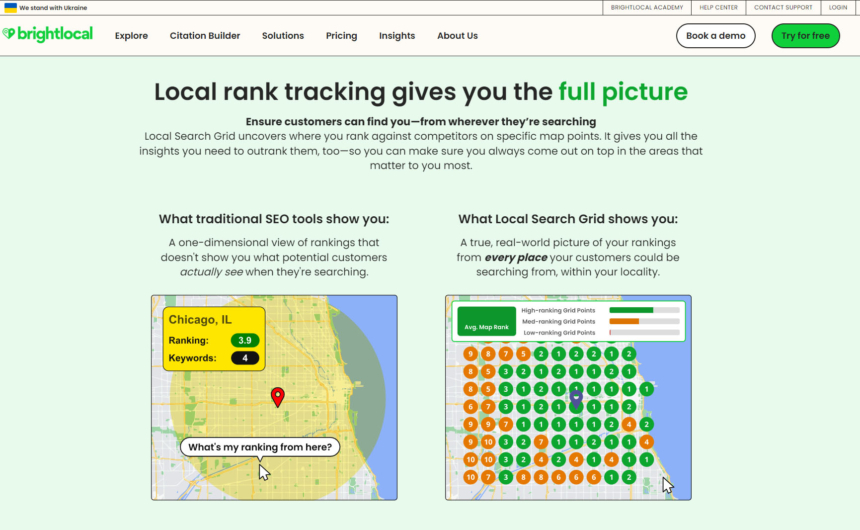
What notable features does Local Search Grid have?
- White-label reports
- Competition ranking factors shows the five most influential factors contributing to your rivals’ rankings
- Competitor location comparison
- Average Map Rank: proprietary metric
- SERP screenshots
- Multiple keywords trackable per location
- Suitable for service-area businesses
- Flag competitor GBP listing spam to Google
- Access to the BrightLocal platform, with other local SEO tools
What grid sizes are available on Local Search Grid?
There are three preset grid sizes available in BrightLocal’s packages, but you can tailor your grid with up to 49 gridpoints:
- 3×3
- 5×5
- 7×7
Points are flexible and you can set a custom distance between points on the grid.
Can I choose the time my report runs?
Yes, you can specify a date and time for your report runs.
How much does Local Search Grid cost?
BrightLocal’s subscriptions come with a grid size up to 7×7 with 5 keywords included in the price. These can be scheduled to run monthly or weekly, depending on how much visibility you would like. Should you wish to use larger grids or more keywords (up to 30), we have a selection of add-ons available within your account. Prices start from $0.0035 per grid point search, depending on location quantity and grid size.
Can I get a free trial of BrightLocal?
Yes. BrightLocal offers a free 14-day trial with up to 50 locations and five keywords per location.
Third-party Reviews of Local Search Grid
No review pages are currently available for Local Search Grid as an individual tool.
Third-party Reviews of the Complete BrightLocal Platform
- G2: 4.6/5 (219 reviews)
- Capterra: 4.8/5 (269 reviews)
- Trustpilot: 4.9/5 (705 reviews)
- TrustRadius: 7.7/10 (38 reviews)
- GetApp: 4.8/5 (269 reviews)
- Gartner: 4.1/5 (12 reviews)
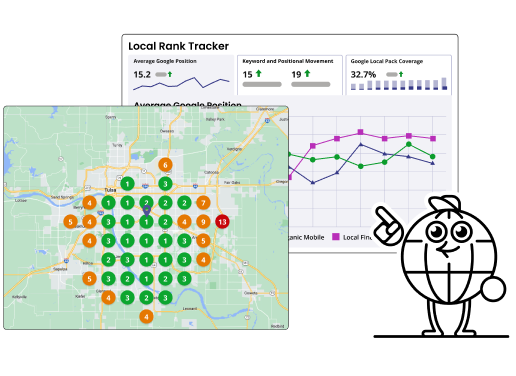
Put Your Rankings on the Map. Literally.
Track and improve rankings with BrightLocal
Local Falcon
Tagline: “Get 100% Local Search Visibility”
URL: https://www.localfalcon.com/
Local Falcon was the first tool to offer grid-style local search ranking tracking, way back in 2018. A year later it was acquired by dbaPlatform, which offers a range of other local search and ads tools. Since then, it’s focused on adding additional functionality with its most recent innovation being AI-powered recommendations and analysis.
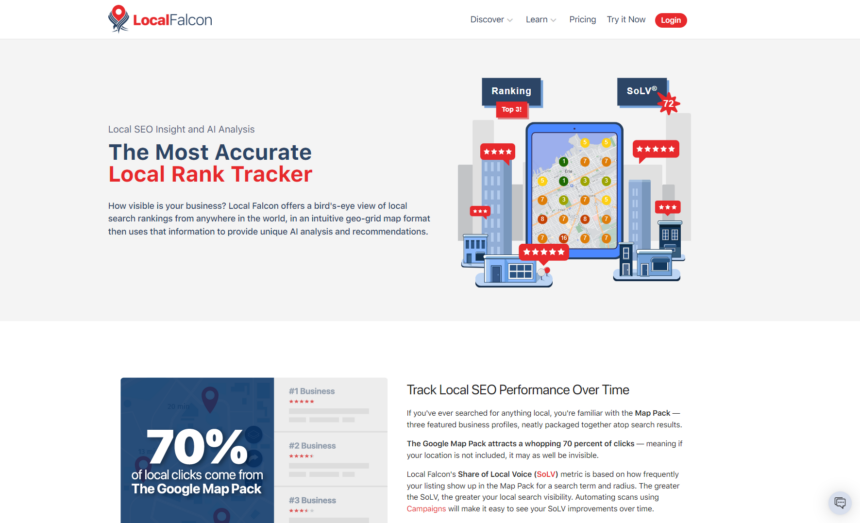
What notable features does Local Falcon have?
- Multiple report types and templates including a white label option
- Competition ranking factors tracking
- AI analysis and recommendations to outrank competitors and improve performance
- Customizable grid point locations
- Metrics including SoLV™ (share of local voice)
- Multiple keywords per location
- Export to CSV
- Suitable for service-area businesses and businesses with multiple locations
- Keyword suggestions for map scans
- Google Looker Studio integration
- Zapier integration
- Users also have the option of monitoring local search rankings for Apple Business Connect listings on Apple Maps
What grid sizes are available on Local Falcon?
There are nine grid sizes available for Local Falcon:
- 3×3
- 5×5
- 7×7
- 9×9
- 11×11
- 15×15
- 17×17
- 19×19
- 21×21
Grid placement in Local Falcon is flexible.
Can I choose the time my report runs?
Yes, you can specify a date and time for your report runs.
How much does Local Falcon cost?
Local Falcon uses a credit system, with the choice of a monthly or annual package.
- Starter: $24.99 per month with 90,000 credits ($0.00028 per credit)
- Basic: $49.99 per month with 180,000 credits ($0.00028 per credit)
- Pro: $99.99 per month with 372,000 credits ($0.00027 per credit)
- Premium: $199.99 per month with 756,000 credits ($0.00026 per credit)
You can find package inclusions and pricing on the pricing page here.
Can I get a free trial of Local Falcon?
Yes. 100 credits are included, which is the equivalent of 11 3×3 scans.
Third-party Reviews of Local Falcon
- G2: 4.7/5 (10 reviews)
- Capterra: (0 reviews)
- TrustRadius: (0 reviews)
Third-party Reviews of the Complete Local Falcon Platform
The Local Falcon platform only offers geogrid rank checking; therefore, the above reviews apply both to the rank checker tool and the platform as a whole.
Local Viking
Tagline: “See Your GMB Rankings In A New Light”
URL: https://localviking.com/geogrid-visibility-tracking
Launched in 2017, Local Viking predominantly offers tools to aid in Google Business profile management, including automated posting, review management, and automated content creation. It gathers information using the Google Places API and regularly adds new functionality. At the time of writing, its latest addition was the ability to compare two GeoGrid reports side by side to show ranking progress over a specific period of time.
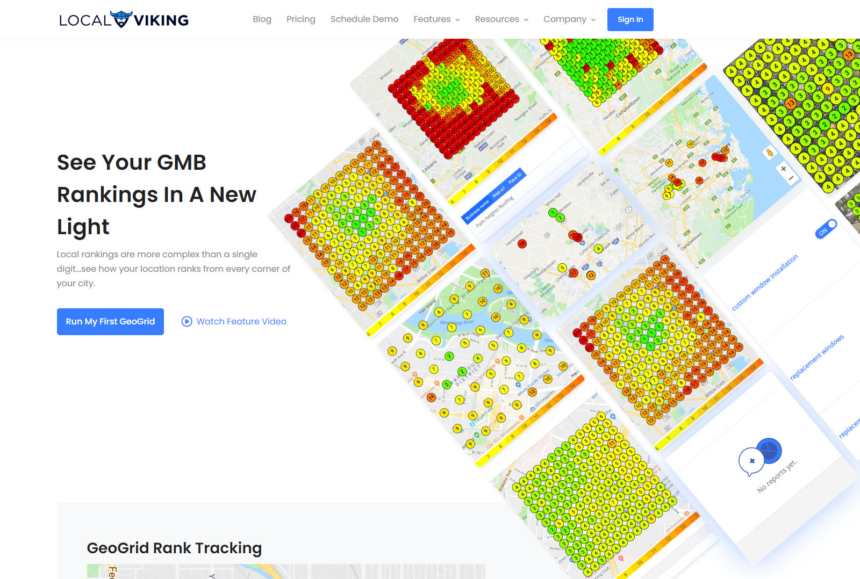
What notable features does Local Viking have?
- Reports can be exported to CSV
- You can create a timelapse GIF report to show progress over time
- Public link option allows you to view results from any angle, with pan, zoom and swivel functionality
- White-label reports (Pro, Agency, and Enterprise plans only)
- GeoGrid widget to generate leads from your site (Pro, Agency, and Enterprise plans only)
- SERP screenshots
- Track competitor rankings
- Access to the Local Viking platform, with other local SEO tools
- Ability to report spam listings
What grid sizes are available on Local Viking?
Points are flexible so you can exclude nodes that aren’t required (for example, because they are in a body of water). There are five grid sizes available:
- 3×3
- 5×5
- 7×7
- 9×9
- 13×13
Can I choose the time my report runs?
No. You can choose to run a report on demand at any time, but you can’t pre-schedule a report for a specific time on a specific day. The most you can do is choose a specific day of the week.
How much does Local Viking cost?
Local Viking’s grid tracker is included with its wider tool offering and not available to purchase as a standalone tool. There are five packages to choose from, with the option of monthly or annual billing. Those opting for an annual package receive two months free.
- Single: $39 per month with 7,500 GeoGrid credits ($0.0052 per credit)
- Starter: $59 per month with 8,100 GeoGrid credits ($0.0073 per credit)
- Pro: $99 per month with 16,200 GeoGrid credits ($0.0061 per credit)
- Agency: $149 per month with 24,300 GeoGrid credits ($0.0061 per credit)
- Enterprise: $200 per month with 32,400 GeoGrid credits ($0.0062 per credit)
You can find out more about Local Viking’s plans and pricing here.
Can I get a free trial of Local Viking?
No. Local Viking doesn’t currently offer a free trial, but they do have a no questions asked full refund within seven days of signing up.
Third-party Reviews of the Complete Local Viking Platform
- G2: (0 reviews)
- Capterra: (0 reviews)
- TrustRadius: (0 reviews)
Local Viking doesn’t appear to have any presence on the more popular software review sites, but it does gather its first-party customer feedback from Facebook together on one page on its site.
Third-party Reviews of Local Viking GeoGrid
There are currently no third-party reviews on the most popular review sites.
Local Dominator
Tagline: “The most accurate and affordable Google Maps rank tracker, built with you in mind”
URL: https://localdominator.co/
Local Dominator’s geo rank tracker is part of a larger Google Business Profile toolset. It offers a range of features designed primarily for agency businesses including keyword research, backlink analysis and Google Business Post scheduling. It offers a user-friendly dashboard and helpful data insights. There’s also an affiliate program for agencies recommending Local Dominator to their clients.
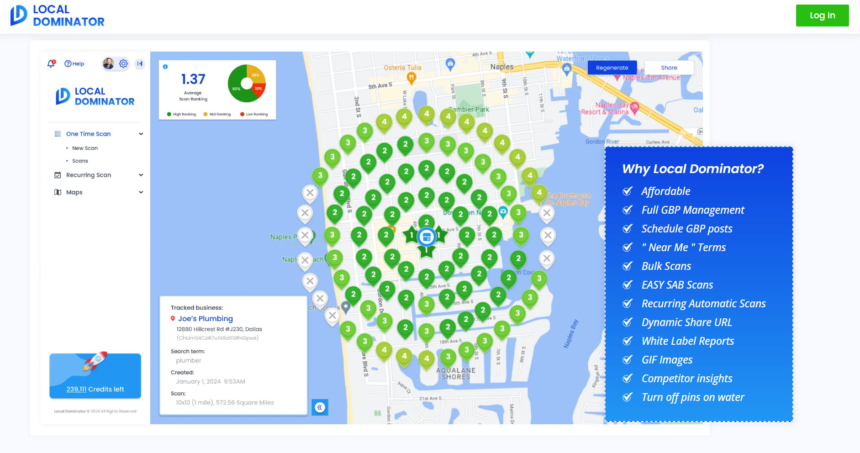
What notable features does Local Dominator have?
- White-label reports
- Dynamic share URL to share ranking information with clients
- Get competitor insights to see how other local businesses are outperforming your listings
- Rolling credits
- Access to additional Google Business Profile management tools
- Leads Extractor plugin to assist with sales prospecting
- Bulk keyword research
What grid sizes are available on Local Dominator?
There are eight grid sizes available, and points are flexible, so you can turn off the pins you don’t want to track. The grid sizes are:
- 6×6
- 7×7
- 8×8
- 9×9
- 10×10
- 11×11
- 12×12
- 13×13
Can I choose the time my report runs?
Yes.
How much does Local Dominator cost?
There are four pay monthly packages available:
- Advance: $59 per month with 15,000 credits ($0.0039 per credit)
- Pro: $97 per month with 36,000 credits ($0.0027 per credit)
- Powerhouse: $197 per month with 81,000 credits $0.0024 per credit)
- Enterprise: $399 per month with 178,000 credits ($0.0022 per credit)
You can find plan and pricing information here.
Can I get a free trial of Local Dominator?
Local Dominator doesn’t offer a free trial, but it does offer a 95% discount in month one.
Third-party Reviews of the Complete Local Dominator Platform
- G2: (0 reviews)
- Capterra: (0 reviews)
- TrustRadius: (0 reviews)
Local Dominator doesn’t appear to have any presence on the more popular software review sites, but it does have eight reviews on its own Google Business Listing.
Third-party Reviews of Local Dominator Google Maps Rank Tracker
There are currently no third-party reviews for the Local Dominator Google Maps Rank Tracker tool.
Semrush
Tagline: “Monitor your Google Maps rankings with pinpoint accuracy”
URL: https://www.semrush.com/map-rank-tracker/
Founded in 2008, Semrush is synonymous with SEO. The all-in-one tool offers a range of solutions for marketers managing SEO, PPC, PR, content and various other digital campaigns.
Map Rank Tracker was previously only available as part of its Listings Management tool but has been expanded and further developed to become a standalone tool with an array of features.
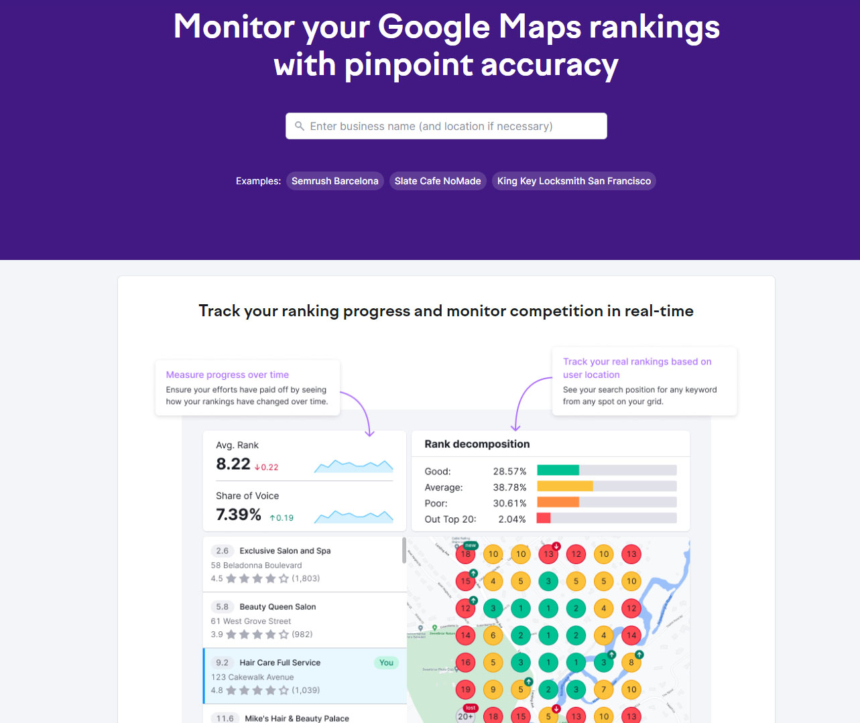
What notable features does Semrush’s Listings Management Heatmap have?
- Local visibility metrics include share of voice data, average ranking, and rank distribution
- Easy access to competitor intel including top 20 rankings for any given search term
- Downloadable PDF reports
- Track an unlimited number of keywords
- Monitor progress over a period of time
- Set your prefered grid size and distance for more meaningful ranking insights
What grid sizes are available on Semrush?
There are six grid sizes available for Semrush, and points are flexible:
- 5×5
- 7×7
- 9×9
- 11×11
- 13×13
- 15×15
Can I choose the time my report runs?
No. The scheduler only permits users to select a report frequency and day of the week, not a specific time of day.
How much does Semrush cost?
Map Rank Tracker is available as part of wider Semrush packages and can be purchased as a standalone tool. If you only want access to the Map Rank Tracker tool, there are two packages to choose from:
- Map Rank Tracker Basic plan: $30 per month with 4,000 credits ($0.0075 per credit) and one campaign.
- Semrush Local Premium Plan: $40 per month with 2,500 credits ($0.016 per credit) and one campaign.
Extra credits can be purchased for $5 per 1,000 credits while additional campaigns cost $10 per month. You can find more information on pricing here.
Can I get a free trial of Semrush?
Yes, there’s a free plan with 50 credits (enough to perform two 5×5 grid searches).
Third-party Reviews of the Complete Semrush Platform
- G2: 4.5/5 (2,002 reviews)
- Capterra: 4.7/5 (2,221 reviews)
- Trustpilot: 4.1/5 (689 reviews)
- TrustRadius: 8.5/10 (722 reviews)
Third-party Reviews of Semrush Map Rank Tracker
There are currently no third-party reviews for the Semrush Map Rank Tracker tool.
Places Scout
Tagline: “Geo-matrix ranking reports”
URL: https://www.placesscout.com/geo-matrix-ranking-reports
Founded in California, USA, in 2011, Places Scout is an all-in-one SEO tool for local businesses and agency users. Its automated local SEO analysis covers more than 400 different data points. Other tools include reputation management, citation management, brand audits, competitor analysis, and lead generation. The Geo-Matrix Ranking Reports tool debuted in May 2020. One of its standout features is the fully customizable animated GIF export function to highlight performance changes in an engaging and accessible manner.
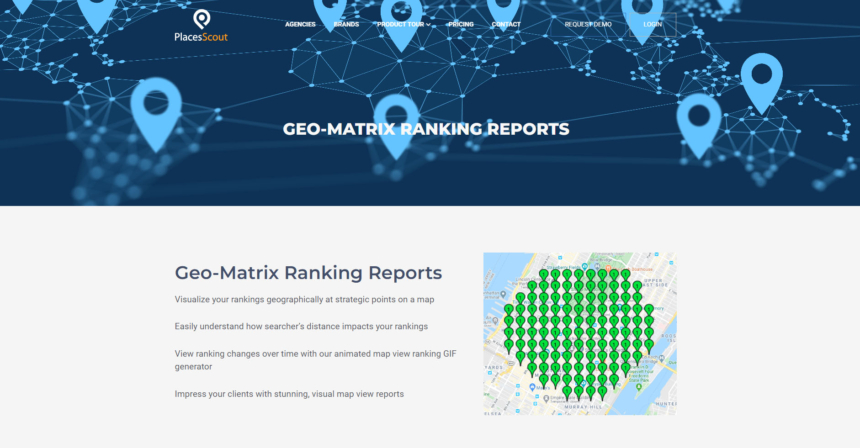
What notable features does Places Scout have?
- Animated map view ranking GIF generator to illustrate performance over time
- White-label reporting (PDF only) with visual map view reports
- Access to the Places Scout platform, with other local SEO tools
- Customizable grid point locations
- Competition ranking factors tracking
- Suitable for service-area businesses
- Multiple keywords per location
- Export to CSV
- SERP Screenshots
What grid sizes are available on PlacesScout?
Points are flexible so you can turn off undesirable locations. There are six grid sizes available:
- 3×3
- 5×5
- 7×7
- 9×9
- 11×11
- 13×13
You can also create a custom grid if required.
Can I choose the time my report runs?
Yes, you can schedule to run reports on a one-time, hourly, daily, weekly, or monthly basis and select the day and time to run the reports.
How much does Places Scout cost?
Pricing information isn’t publicly available. You’ll need to complete the package request form to get a custom quote.
Can I get a free trial of Places Scout?
No, Places Scout doesn’t offer a free trial, but you can schedule a demo.
Third-party Reviews of the Complete Places Scout Platform
G2: 4.5/5 (1 review)
Capterra: (0 reviews)
TrustRadius: (0 reviews)
Cuspera: 4.08/5 (63 reviews)
Third-party Reviews of PlacesScout Geo-Matrix Ranking Reports
There are currently no third-party reviews of the PlacesScout Geo-Matrix Ranking tool.
Localo
Tagline: “Reach new customers in your area with our local SEO tool”
URL: https://localo.com
Localo was founded in 2020 and is based in Krakow, Poland. Its local rank tracker is part of a wider suite of local SEO solutions. Those solutions also include tools to create and schedule Google Business posts, citation management and web page creation for local businesses. It also offers an AI Google Business Profile Manager which tells business owners and local SEO pros which tasks to complete to grow their local search visibility.
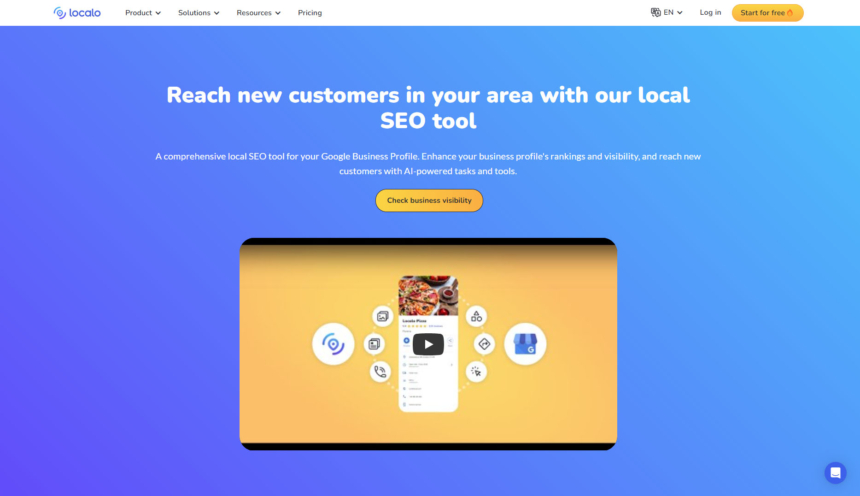
What notable features does Localo have?
- An Area Difficulty Index illustrates how easy or hard it is to rank in any given location
- Available for local businesses worldwide in all languages
- Automated position monitoring
- Suitable for service area businesses
- Competitor activity monitoring
What grid sizes are available on Localo?
Localo uses a smart grid which automates the grid and distance size using an algorithm which determines difficulty level and density of any given areas. Only users who subscribe to the larger Agencies plan for multiple location management can specify a custom grid size.
Can I choose the time my report runs?
No.
How much does Localo cost?
Localo’s pricing is a little different to many of the other options in this guide as it doesn’t operate a credit system. Instead, it restricts the number of locations and keywords to be monitored and charges a fixed fee. The geo grid ranking monitoring feature is part of a wider local SEO toolset and isn’t available as a standalone service.
There are two package options, payable monthly or yearly.
- Growth: $29 per month, per location for up to 10 keywords.
- Agencies: $99 per month for up to four locations, with 10 keywords per location.
You can find details of pricing and package inclusions here.
Can I get a free trial of Localo?
Yes. Localo offers a free plan, with a limit of one Google profile and ten search terms.
Third-party Reviews of the Complete Localo Platform
- G2: 4.9/5 (107 reviews)
- Capterra: (0 reviews)
- TrustRadius: (0 reviews)
Third-party Reviews of Localo Rank Tracker
There are currently no third-party reviews of the Localo Rank Tracker tool.
GMB Crush
Tagline: Local 3-pack domination made easy
GMB Crush is a local listings management platform with audit, optimization and rank tracking functionality. You can either use GMB Crush to reverse engineer your competitors’ GBP categories, labels, tags, number of reviews, keywords, descriptions of their listings, published media, and GBP posts, to compare it to your own listings to see what to add to outrank your competitors, automatically.

What notable features does GMB Crush have?
- The intuitive geo-grid heat map makes it easy to see where performance is strong and where gaps exist
- Location authority feature identifies the best performing profile across target areas
- Competitor benchmarking
- White label reporting
- PNG and PDF downloadable reports
- Track multiple keywords
What grid sizes are available on GMB Crush?
There are six grid sizes available:
- 3×3
- 5×5
- 7×7
- 9×9
- 11×11
- 15×15
Can I choose the time my report runs?
Unknown. If you know, let us know!
How much does GMB Crush cost?
The grid tracker tool is part of a wider suite of local SEO tools and not available as a single purchase. There are three package options to choose from, with a choice of monthly or annual billing.
- Sidekick: $39.99 per month with 16/250KM Grids included (100 credits).
- Local Hero: $89.99 per month with 40/250KM Grids included (200 credits)
- Superhero: $139.99 per month with 120/250KM Grids included (900 credits).
For details of all package inclusions, visit the GMB Crush pricing page.
Can I get a free trial of GMB Crush?
No, GMB Crush doesn’t offer a free trial.
Third-party Reviews of the Complete GMB Crush Platform
- G2: (0 reviews)
- Capterra: (0 reviews)
- TrustRadius: (0 reviews)
- TrustPilot: 4.7/5 (35 reviews)
Third-party Reviews of GMB Crush Google Maps Geogrid Rank Tracker
There are currently no third-party reviews of the GMB Crush Google Maps Geogrid Rank Tracker.
Conclusion
As you can see, there’s a lot to consider when choosing the geo grid tool, platform and pricing plan that meets your needs, but we hope we’ve shown you what the most prominent ones out there can offer.
We’ve tried to be as unbiased as we can, despite representing one of the above tools, because we’re only interested in providing the most useful, most up-to-date information.
So, if you spot anything out of order in the information, or are aware of anything that needs updating, please do send us an email and we’ll look to get it updated as soon as possible.


